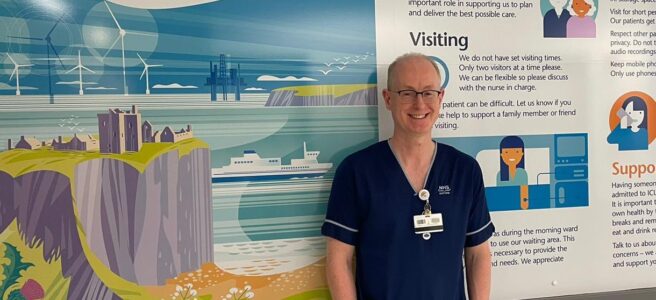NHS Grampian Charity is proud to work with an incredible team of NHS colleagues across the Grampian region. Our colleagues use the generous donations that have been gifted to the charity to benefit patients and to enhance the healthcare services provided by NHS Grampian, both in the hospitals and in the wider community.
One of those colleagues is Steve Marjoribanks, a Senior Charge Nurse at Aberdeen Royal Infirmary’s Critical Care Unit. We spoke to Steve about his work with NHS Grampian, and the difference he has seen your donations make over the years.
I started my career as an auxiliary at Royal Cornhill Hospital some time ago, before moving into general nursing and ultimately to the Critical Care Unit. The unit has always been a fast-paced and dynamic place to work, which is what attracted me from when I was a student on placement. The last few years have been some of the busiest though, Covid was obviously an exceptionally busy time, but there have been many fresh challenges since then as the whole NHS tries to reset itself after the pandemic.
Given the nature of the Critical Care Unit we see the sickest patients in the hospital, and that can range anywhere from an overnight stay to a more significant period of time. While many of our patients make a full recovery and are transferred to other wards or discharged home, sadly not all the patients we look after in Critical Care will return to their families.
Over the years I have been here, I am continually surprised and humbled by the generosity of our former patients and their families. Often these donations come from the family members and friends who have spent many, many hours sitting in the ward or in our waiting area. It is not uncommon for us, for example, to receive donations from funeral collections, and sometimes family members even come straight from the funeral to hand in a donation.
It is an incredible honour and privilege for us to receive any donation for having cared for a patient in Critical Care
I think there is something incredibly sobering about those who are thinking about how they can help others at such an emotionally charged and vulnerable time. Not least when they are back in a clinical environment where they have suffered a loss so very recently. It is an incredible honour and privilege for us to receive any donation for having cared for a patient in Critical Care, especially when the outcome is not what anyone would have wanted. For us, the donation comes with so much more than just a monetary value and its spending capacity to provide comfort to others or help us grow our service. It is also a manifestation of the grief and appreciation of the donor, and we feel a responsibility and a moral obligation to ensure that it is spent wisely and respectfully.
Over the past few years, we have been able to use charitable donations to upgrade and renovate our waiting areas and relative overnight rooms. These public areas have a high footfall and are used often for long periods of time, so obviously we want them to be as comfortable and relaxing as possible. We have three waiting areas outside the unit, all of different sizes to give flexibility in function – all have benefitted in the past from donations to replace seating, flooring, and generally make the room as comfortable as possible.
We have recently been working on one of our waiting areas just outside of the ward. This room is often used for staff and families to hold extremely difficult and emotionally charged conversations, so our staff felt that it was important to make this space as restful and private as possible to create a safe space for those visitors.
We have previously used some donated money to refresh our entrance to both Ward 201 and the other unit in 106b. Both areas now have large, bright and informative posters which display some welcome information for visitors and some guidance on some of the medical equipment they will see while visiting – this is a useful pictorial reminder, given the sensory overload sometimes experienced. These posters have been designed specifically for our unit in Aberdeen, and receive excellent feedback from visitors and staff.
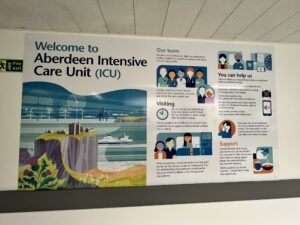
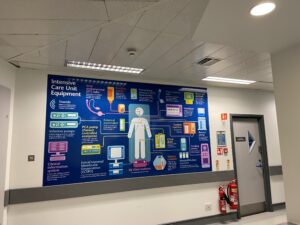
Donations have also funded the development of three overnight rooms to accommodate family members while patients are critically unwell in hospital. With ARI admitting patients from a huge geographic area these rooms, which are right beside Critical Care, allow family members to have an essential space to get some rest and shower, without ever being far from their loved ones. We are very fortunate to have these rooms in Aberdeen – they are used frequently and are hugely appreciated by those who use them.
The charity’s funds are also important for enhancing staff education, over and above what the NHS provides. I was lucky enough to attend the European Intensive Care Conference in Lisbon some years ago, and we still have small cohorts of staff attending similar educational opportunities thanks to charity support, including doctors, nurses, physiotherapists, and other members of the multi-disciplinary team.
Opportunities like this help build the presence and reputation of NHS Grampian and put Aberdeen on the map
Earlier this year, one of our nurses presented a poster at the Intensive Care Conference in Paris. Opportunities like this help build the presence and reputation of NHS Grampian and put Aberdeen on the map, and there are also longer-term recruitment advantages to this. It also demonstrates that our practice is as contemporary as everywhere else and we are doing as well as, and sometimes better than, other cities and other countries. Staff return from these events with a sense of pride and confidence that Grampian holds its own on the world stage. There is also the opportunity to share any new knowledge with the local team thereby developing our service and, ultimately, our patient care.
Donations have also helped us to carry out some much larger projects too. Back in around 1995, Ward 201 (one of our now two Critical Care Units) was extended to create an additional 9 beds, but this replaced a lot of windows with a wall. Consequently, this made the unit quite dark, particularly in winter. In 2011 the charity supported the installation of a ‘Sky Ceiling’ which mimics natural daylight and brings huge benefits to both staff and patients. Some of our patients are in the unit for months at a time and this ceiling provides not only bright ambient light, but a sunny and pleasant vista in an otherwise stark and clinical environment.
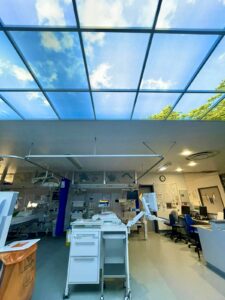
We have also used donations to implement an electronic system at the end of each bed – effectively a computer that helps chart the patients’ vital signs and has allowed us to move to an almost completely paper-free environment. Everything is digital – prescriptions, nursing documentation, medical notes, etc. Prior to this, we had a desk at the end of each bed with patient notes and, as you can probably imagine, this could often be a very large record with a lot of paper. The new system allows us to record every aspect of the patient care electronically and reliably, including their journey and progress without any of the issues of misplaced paperwork or indecipherable handwriting.
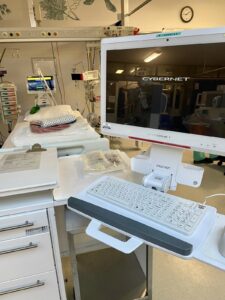
I honestly don’t know what we would have done without this system during Covid. The system allowed us to manage prescriptions and speciality input from outside the unit. It also meant that we could discharge patients from inside the Covid unit, but print the medical/nursing paperwork remotely – thereby ensuring the patient’s notes were transferred to the new ward without risk of contamination, and thus ensured that the record of their care and onward journey was seamless.
I would say it is probably the single biggest thing that has moved the needle on nursing in critical care during my time
In a speciality like Critical Care where everything always evolves quickly, this digital system is our biggest charity project to date and is that which has had the greatest impact on the way we work on a daily basis. I would say it is probably the single biggest thing that has moved the needle on nursing in critical care during my time, and it would not have been possible without the involvement of NHS Grampian Charity.
NHS Grampian Charity could not continue to enhance the health and wellbeing of the people of Grampian without your support. Please click here to make a donation.

